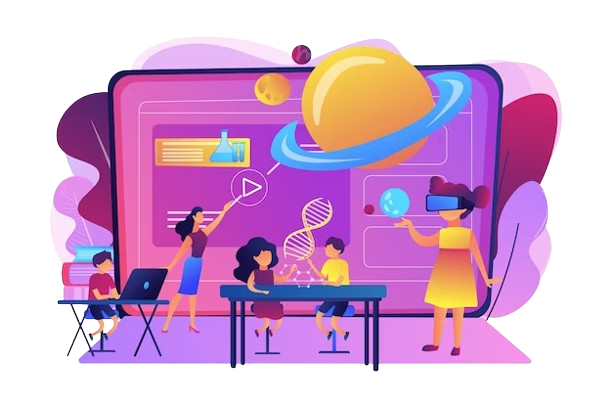
The learning surroundings are more dynamic than ever before. As a result Technology in the Classroom, these days, students examine approaches unique from how our instructional machines were designed initially. With the development of Artificial Intelligence and the upward push of far-off/hybrid getting to know, the concept of the school room is being made over and redefined in some ways to shape the evolving wishes of contemporary virtual newcomers.
Many Higher Education Institutions are substituting conventional resources with academic technologies to accommodate their digital learning population.
1. Access to statistics and resources
Technology gives students instant access to a considerable amount of information and sources. Here are a few concrete examples of the way students can use generation to beautify their studying:
- Digital Libraries: Digital libraries or online databases permit college students to access numerous academic and study substances, including e-books, scholarly articles, journals, and multimedia content that may assist their learning.
- Online Platforms: Educational systems and learning control structures (LMS) provide a centralised region for instructors to share sources and for college students to get admission to records. These platforms can host digital textbooks, multimedia content, interactive modules, and assignments.
2. Connecting the school room reveals the real international.
A geology professor takes her college students on a Grand Canyon National Park virtual tour. A history trainer walks his college students through the corridors and history of the White House. Technology allows educators to eliminate the bodily barriers of the study room, presenting students a way to attach the curriculum with the real global and those regions of academic recognition, which could enrich the pupil revel.
3. Prepares students for the present-day place of job
To thrive in the twenty-first-century place of business, students need more than an operating know-how of present-day technological tools. They must take advantage of publicity about the equipment and competencies they will encounter in the cutting-edge workplace.
- Digital Literacy: Digital literacy abilities are in high demand in the place of business.
- Information Management: Technology permits college students to get admission to, organize, and analyze big quantities of records. Employees regularly want to gather information and conduct studies to make informed choices. Technology in the Classroom technology familiarizes college students with data management gear and strategies, preparing them for these duties.
- Adaptability and Flexibility: Technology integration exposes college students to numerous digital equipment and systems. This enjoyment helps college students grow to be adaptable and flexible in using unique technologies, as offices frequently require employees to research and adapt to new technologies and software programs.
- Creativity and Innovation: Students can use technology to create multimedia displays, layout projects, expand prototypes, and explicit their ideas innovatively. These abilities are extraordinarily valued in many industries where creative trouble-fixing and innovative questioning are critical.
- Encourages collaboration and communique: Many academic tools offer many functionalities that promote collaboration. This mirrors the teamwork and communication talents required in any place of work.
4. Global consciousness and cultural change
Technology in the Classroom permits students to connect to peers and professionals from around the sector. Through video conferencing, online collaborations, and virtual exchange programs, students can benefit from global recognition, learn about specific cultures, and increase a broader perspective on diverse troubles.
5. Supports special kinds of learning styles
No two students analyze equally, but educators can deal with diversity by studying patterns and reports with the right tools. A Student Insight Solution platform like Explorance Blue can assist in discovering scholar wishes based on actual-time remarks. Explorance Blue supports scholar mastering by permitting teachers to attach and engage with every student, no matter where they are or their demanding situations.
You May Also Read Our Latest Blog: Top 10 IT Companies in The World | Largest IT Services 2024
6. Teaches students the way to be accountable online
With social media sites galore, most college students are already digital residents. However, by incorporating the era into the schoolroom, college students can discover ways to be accountable in the virtual world and with their virtual moves. The Technology in the Classroom becomes a microcosm of the broader digital panorama where college students can practice speaking, looking, and being attractive to different virtual residents.
7. Adds a fun aspect to mastering
Outside the lecture room, students use the era in all components. The generation could make studying more laugh and thrilling within the lecture room. Here are some laugh ways to incorporate generation into study Technology in the Classroom room activities:
- Educational Games and Quizzes: Utilize educational game websites or apps that offer interactive quizzes, puzzles, and challenges related to the situation count number. This engages college students in an amusing and competitive environment while reinforcing their getting to know.
- Online Polls and Surveys: Use online polling gear or survey systems to gather pupil feedback, conduct magnificence surveys, or facilitate elegant discussions. This encourages active participation and allows students to explicit their minds.
- Coding and Programming: Introduce coding and programming activities using instructional coding systems or apps. Students can learn the basics of coding via recreation-based tutorials, after which they follow their skills to create simple applications or animations.
- Augmented Reality (AR) and Virtual Reality (VR): Explore AR and VR technology to create immersive and interactive learning experiences. Students can use AR/VR tools to explore historic sites, dissect digital organisms, or visualize complicated standards in a 3-dimensional space.
Effective instructors leverage generation to beautify their practice and engage students. However, it’s crucial to ensure that students are guided on efficiently searching for information, significantly evaluating sources, and the usage of technology responsibly. Instructors are essential in helping students navigate the virtual landscape and broaden statistics literacy capabilities.




Leave a Comment